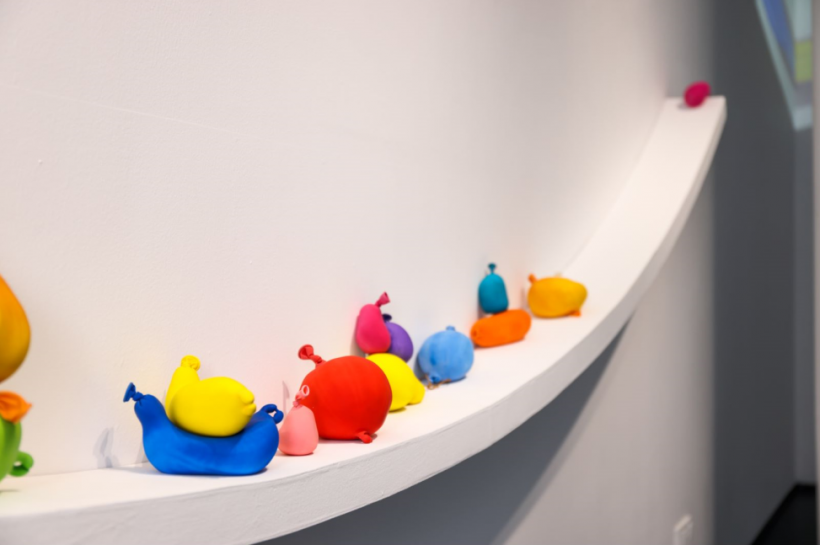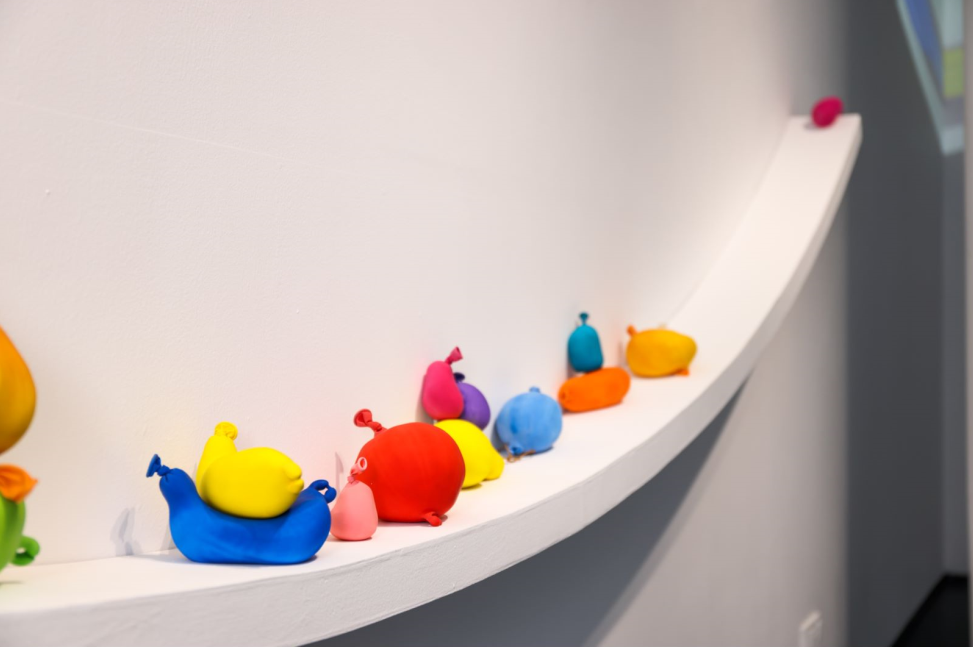Talk With Ma Wenyi |“Composing work is like writing a diary”
BAM: Hi Wenyi, your exhibition is titled ‘Merry-go-round’, which reminds me of the entertainment facility in an amusement park, would you like to share what this title means to you?
Wenyi: The title of this exhibition is inspired by my experience of editing the video clips. These clips that are originally single-channel images, they were then generating a kind of new effect, or, ‘interaction’ with each other when I occasionally juxtaposed one of them with another one during my editing. In fact, this kind of interaction is the result of random and accidence beyond my control. For instance, in my video work Merry-go-round (series 1), I am breathing the air in or out in two different balloons at different time, these actions are simple and intuitive, the two balloons in the video didn’t have any specific connection at the beginning, however, they generated a new rhythm and interaction when I juxtaposed two screens together, it seems that the balloons ‘meet’ physically, in fact, they don’t. Back to the merry-go-round, the model horse in the revolving machine constantly chase the front horse but never catch up with any of them. Also, the horses in merry-go-round sometimes move rapidly and sometimes slowly, which, more or less, reflects my recent mental status.
BAM: No matter the merry-go-round or balloons, they are usually used in festivals or the celebration occasions. In contrast, in your work, we can see something calm and thoughtful. Why did you want to explore a theme like this? What brings you the ideas of this series of work?
Wenyi: I came up with the ideas of these works at home during the pandemic outbreak from March to September in the UK. I chose to shoot videos of balloons because a video camera and balloons were the materials I had at that time. Actually, the outcome exceeds my expectation. And in the process of shooting exploration, there were a lot of accidental new discoveries, which also made me very excited. For example, when I was shooting White, it was similar to a process of subtraction, from utilizing multi-colour background and various balloons to only utilizing only white background and white balloons. From my perspective, white refuses a clear direction or a definite reference. I don’t want my works to be simply classified or defined as a certain genre, and the fewer elements involved, the purer it will be.
BAM: Your works cannot be easily defined, that means, the audiences can read your works from different angles.
Wenyi: You are right! The idea of this work is also inspired by one of my previous work, say, an installation of balloons and wood. I enjoy the tension generated from the balloon itself, especially one of its physical states that the layers of the balloons are thinned by expansion. But, after some time, some balloons within that installation work had broken. What’s more, the traditional wooden frame I used for that installation has been pulled out of shape, from an ordinary rectangle to a diamond. It was from that moment that I found rubber materials such as balloons cannot be completely controlled by me. I used to apply various symbols or elements from a certain cultural background in my previous practices. The problem is, symbols are easy to be classified. For example, if you mention ‘bamboo’ in Chinese traditional culture, we may think of the literati paintings or the literati’s noble character(gao feng liang jie), but in fact, whatever the noble character or literati paintings, this kind of meaning or explanation, are all given by us instead of the material itself. Like balloons, many people just think they are playful, in contrast, balloons have various potential natures that we even don’t know, therefore they should not be simply classified. Based on that, I deem my work needs to be subtracted and find ways of tracking back to the material itself. The tension within the balloons is the purest power I have ever seen, and it exists as an inherent nature which is not given by me.
BAM: This series of works are closely connected with your mental state. Like what you said, you do not want your works to be considered as any specific style or genre. White is a kind of pure colour, just like what you want to achieve, i.e., you want to see the world innocently. We notice that in your video work white, you try to control the white balloons which show different status, sometimes they are tightened, sometimes they are loosened, or even twist together.
Wenyi: The shooting of White went through a long process. I planned to use wooden frames and balloons. During my shooting practice, I found that there was no need for using wooden frames since the balloon itself is far enough to express what I want to achieve. I subtracted the wooden frames then. The balloons I used at the beginning have various colours, and what I found in the process is that the balloons having various colours would indicate different meanings or generate certain psychological implications. To purely present the subtle tension generated within the balloons, I finally chose to shoot videos of white balloons in a white background.
BAM: Could we consider the expansion, contraction, interweaving, and shaking of the balloons in White as a kind of metaphor of your inner state when you were working as an artist at that time?
Wenyi: Yes, when I am making an artwork, I feel like writing diaries of myself. In particular, during the lockdown in the UK, I felt that everything around me was beyond my control, and everything had become unpredictable. Also, when I am making an artwork, I often change my mind and remake it.
BAM: As for the works you exhibit this time, have you expected anything specific that the audiences might think about?
Wenyi: No, I haven’t. I cannot control what the audiences might think. I can only present what I believe.
BAM: As your first solo exhibition, the four works you exhibit can be regarded as a summary of your thoughts and ideas at a certain stage during your artist career. What are the internal relations and differences between the four works in the exhibition?
Wenyi: In White, I simply concentrate on the balloon’s tension. Whilst in the video series Merry-go-round, what I planned to do is to unconsciously record the subtle change of the balloons when they are injected with liquid for representing their tensions. However, as I mentioned before, when I edited the clips I shot, I found the ‘interaction’ between these balloons when I juxtaposed different clips, and it obviously produces a new visual effect, which makes Merry-go-round go further than White.
BAM: In White, I simply concentrate on the balloon’s tension. Whilst in the video series Merry-go-round, what I planned to do is to unconsciously record the subtle change of the balloons when they are injected with liquid for representing their tensions. However, as I mentioned before, when I edited the clips I shot, I found the ‘interaction’ between these balloons when I juxtaposed different clips, and it obviously produces a new visual effect, which makes Merry-go-round go further than White.
Wenyi: All these works came from my previous experience. I tried to connect balloons and a wooden frame into an installation work, but in that work the softer balloons broke and the harder wooden frame broke as well. It reminded me of an ideas: what if I use the balloons to cover the soft things that can be reshaped? So I started to use water, but water left nothing after my touching. Then, I filled with sand, when I touched it, my action reshaped balloons’ surface. They seemly remember someone who has touched them. Moreover, They are so easy to produce, everyone including children can make one for themselves and then share with others. In other words, this work[Bollards] is close to its audiences instead of creating a sense of distance, I noticed that the audiences would love to play with them, and reshape them, leave their ‘marks’ which will be eventually reshaped by someone else. All in all, instead of being still, Bollards is a kind of work that constantly changes, and thus brings art closer to the audiences, which fascinates me.
BAM: Could you tell more about the title of Bollards?
Wenyi: Bollards are something common, they are, kind of, pillars, and you can easily find them in roads or streets. They function as something to discipline pedestrians and cars. Actually, they are obstacles themselves. Comparing with that, my bollards are totally different, I wish my bollards to interact with audiences, and makes them feel a sense of closeness.
BAM: Could you share your favourite artists?
Wenyi: Quite a lot, yet I haven’t imitated any of them in my practices. One of them is Burce Nauman, I visited his retrospective exhibition in Tate Modern recently. I have to say, his works are so vivid. He constantly stretches himself to his limits, that’s why I can see he made distinct things in different stages during his life while he was in several totally different statues. I mean, for artists, keeping challenging himself and breaking through his previous practices will be a hard journey, and that is the thing I have to encounter.
BAM: Indeed! Sometimes it does hard for many artists to view their works critically, and in most cases those artists just repeat himself. So, what is your plan in the next few years?
Wenyi: Find inspirations from my daily life and Keep making artworks. Anyway, I don’t want to limit my practices into a specific area or genre.
BAM: Great! Thank you for your sharing today!


